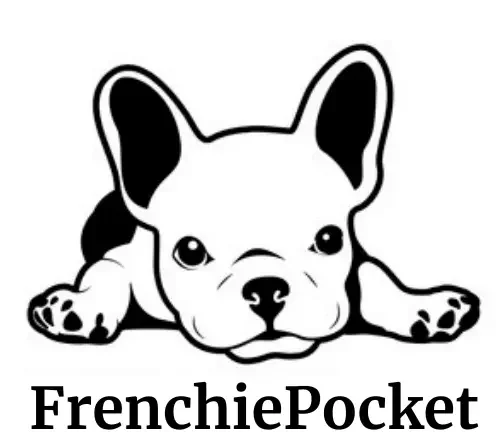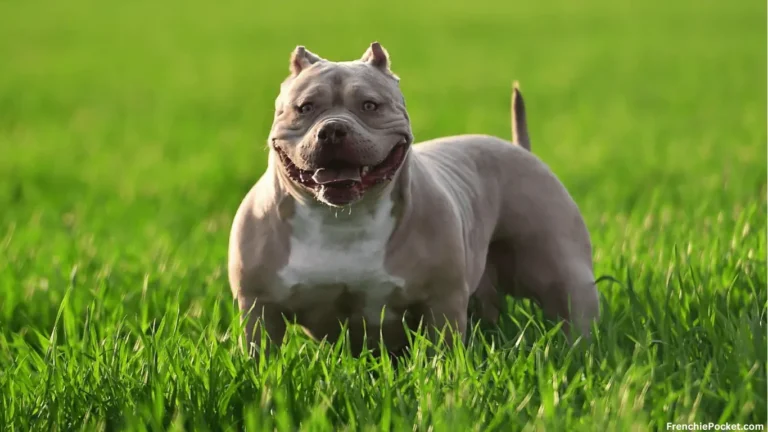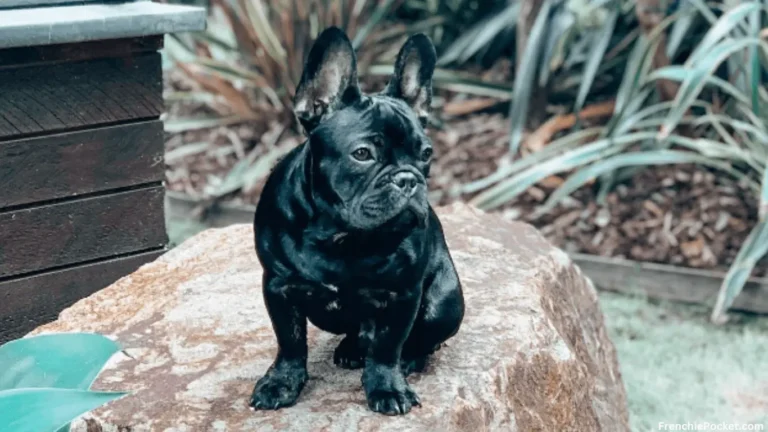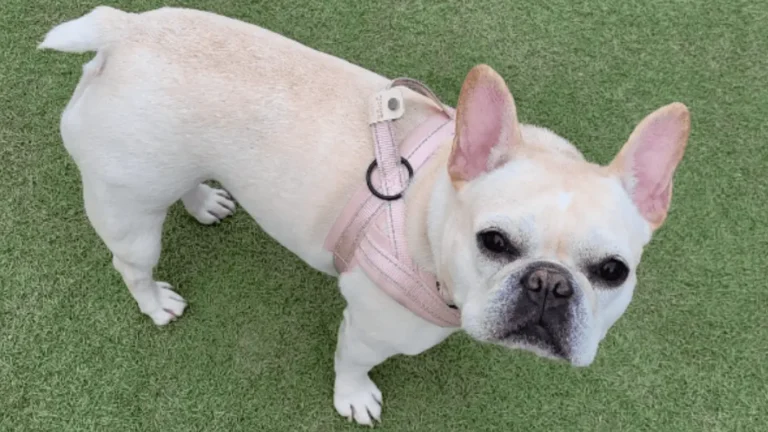French Bulldogs Tails
French Bulldogs are adorable, charming, and popular companion dogs known for their distinct features, including their short and often curly tails.
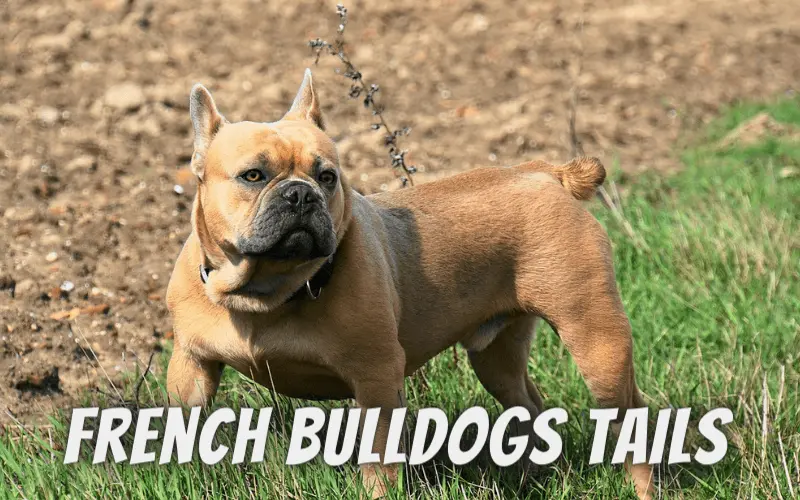
Many people often wonder if French Bulldog’s Tails have their crop. But actually, their tails are naturally short and can come in three different shapes.
If you already have a happy French Bulldog or are thinking of getting one, this detailed guide will give you valuable information about this adorable breed.
| Tail Type | Natural Short Tail, Screw or Corkscrew Tail |
| Tail Length | Short |
| Tail Position | Low-set and carried low |
| Tail Docking | Generally, not docked (natural tail) |
| Tail Characteristics | Screw-shaped or straight, but not tightly curled |
| Tail Function | Primarily ornamental, does not serve any specific purpose |
French Bulldog Tail Types
Natural Short Tail
The most common tail type in French Bulldogs is the natural short tail. These puppies are born with short tails, which are straight and have a smooth appearance. The length of the tail may vary slightly among individuals, but it is generally short and does not extend beyond a few vertebrae.
Screw Tail
Some French Bulldogs may have a screw tail, which is characterized by a slight twist or curve in the tail. The screw tail is still relatively short but has a distinct corkscrew-like appearance. This tail type adds to the breed’s unique charm and individuality.
Corkscrew Tail
The corkscrew tail is more pronounced than the screw tail, displaying a tighter and more distinct spiral shape. While still short in length, this tail type can have a more noticeable twist, giving the French Bulldog an adorable and quirky feature.
The tail type can be influenced by genetics and breeding. Additionally, some French Bulldogs may have longer tails due to genetic variations or mixed breeding with other dog breeds.
French Bulldogs born without Tails
French Bulldogs born without tails, also known as natural bobtails, exhibit a captivating and rare trait that adds to their charm and allure. This genetic quirk is a result of a mutation in the T gene, and when both parent dogs carry this mutation, their offspring may be born without a tail. Fortunately, taillessness does not pose any health risks to these beloved companions, and they can lead fulfilling and joyful lives.
Remember, it’s the unique personalities and loving nature of these furry friends that truly make them exceptional pets.
Causes of Taillessness
Taillessness in French Bulldogs is primarily a hereditary trait. As mentioned earlier, it occurs when both parent dogs carry the T gene mutation. If a puppy inherits this mutation from both parents, it will be born without a tail. It’s essential to note that not all French Bulldogs will have this trait, as it depends on the genetic combination of the breeding pair.
French Bulldog Tail Issues
Tail Pocket Infections: French Bulldogs have short and sometimes wrinkled tails, which can create pockets where dirt, debris, and moisture can accumulate. Tail pockets can turn into homes for bacteria, causing painful infections. Regular cleaning and proper hygiene are essential to prevent and address tail pocket infections.
Tail Injuries: Due to their playful and energetic nature, French Bulldogs are prone to tail injuries. They may accidentally bump their tails against furniture or get their tails stepped on during playtime. Tail injuries can range from minor bruising to more severe conditions like fractures or sprains.
Tail Fractures: French Bulldog tails are short and can be susceptible to fractures, especially if the dog experiences a sudden impact or trauma to the tail. Tail fractures can cause pain and need prompt veterinary care.
Hemivertebrae: Some French Bulldogs may be born with a genetic condition called hemivertebrae, where one or more vertebrae in the tail are deformed or misshapen. This condition can be painful and uncomfortable and may result in spinal cord problems if not treated.
Tail-Chewing or Gnawing: French Bulldogs, like many other breeds, may exhibit tail-chasing or tail-chewing behavior. This behavior can be due to boredom, anxiety, allergies, or skin irritations. To prevent further tail damage and discomfort, it is crucial to address the underlying cause.
Tail Amputation (Docking): Tail docking, the practice of surgically removing a portion of the tail, was historically done for certain breeds, including French Bulldogs. However, many countries and regions have banned tail docking due to ethical reasons, and it is no longer considered a standard practice.
French Bulldog Tail Pocket Infection Treatment
Remember that tail pocket infections can be uncomfortable and painful for your French Bulldog. Early detection and proper treatment are crucial for a full and speedy recovery. Always follow your veterinarian’s advice and recommendations for the best outcome.
Consult a Veterinarian: The first step is to schedule a visit to your veterinarian as soon as you suspect a tail pocket infection. A professional evaluation will confirm the diagnosis and assess how severe the infection is.
Keep the Area Clean: Before your vet appointment, gently clean the tail pocket area with a damp, soft cloth and mild dog-friendly shampoo. Performing this action aids in removing debris and accumulated dirt, thereby reducing the likelihood of future infections.
Topical Antiseptic Solution: Your veterinarian may prescribe a topical antiseptic solution to clean the infected area. Follow their instructions carefully and administer the solution as directed.
Antibiotics: Your veterinarian might prescribe oral antibiotics to fight the infection. Ensure to follow the prescribed dosage and complete the full course of antibiotics, even if the symptoms improve.
Warm Compress: Applying a warm compress to the tail pocket area can help soothe the inflammation and promote drainage. Use a clean, warm, damp cloth and gently press it against the infected area for a few minutes several times a day.
Maintain Proper Hygiene: Keep the tail pocket area clean and dry while it heals. Regularly check and clean the area to prevent any further buildup of moisture or debris.
Monitor Progress: Keep a close eye on your French Bulldog’s tail pocket and observe any changes in behavior or signs of improvement. If the infection does not improve or worsens, contact your veterinarian immediately.
Preventive Measures: To prevent future tail pocket infections, incorporate regular tail pocket cleaning into your Frenchie’s grooming routine. Use a dog-specific cleaning solution or baby wipes to gently clean the area, being mindful of their comfort.
Weight Management: Obesity can exacerbate tail pocket infections in French Bulldogs. Maintain an appropriate weight for your dog with nutritious food and regular exercise.
Consider Tail Pocket Surgery: In severe or chronic cases, your veterinarian may recommend surgical intervention to address the tail pocket issues. Surgery can help create a more accessible and hygienic tail area for your Frenchie.
French Bulldog Tail Pocket Cleaning
Regular tail pocket cleaning is crucial for maintaining the overall health and hygiene of your French Bulldog. If left uncleaned, the tail pocket can lead to various issues such as infections, bad odor, and discomfort for your furry companion. By incorporating tail pocket cleaning into your pet care routine, you can prevent potential health problems and ensure your French Bulldog remains happy and healthy.
Preparing for Tail Pocket Cleaning
Collect each of the supplies you need when you start cleansing. You will need:
- Pet-friendly wipes or a mild, veterinarian-approved cleaning solution
- Soft and clean cloths
- A towel for drying
Ensure that the cleaning solution you use is specifically designed for pets, as using harsh chemicals can irritate your French Bulldog’s sensitive skin.
Step-by-Step Guide to Cleaning a French Bulldog’s Tail Pocket
Step 1: Collect the Required Materials
Step 2: Find a Calm and Comfortable Environment
Step 3: Calmly Approach Your French Bulldog
Step 4: Gently Examine the Tail Pocket
Step 5: Use a Pet-Friendly Cleaning Solution
Step 6: Clean the Tail Pocket with a Soft Cloth
Step 7: Drying the Tail Pocket
Step 8: Reward Your French Bulldog
Tips for Maintaining a Healthy Tail Pocket
Aside from regular cleaning, here are some additional tips to keep your French Bulldog’s tail pocket healthy:
- Regular Inspection: Check your pet’s tail pocket on a daily basis for any signs of discomfort or illness.
- Balanced Diet: A nutritious diet will improve your French Bulldog’s overall health, including its skin and coat.
- Keep It Dry: Ensure the tail pocket remains dry, as moisture can lead to bacterial growth.
- Proper Grooming: Regular grooming sessions will help you stay on top of your French Bulldog’s hygiene needs.
Common Mistakes to Avoid
- Using harsh chemicals or human cleaning products on your pet.
- Ignoring signs of discomfort or infection in the tail pocket.
- Forcing your French Bulldog to undergo cleaning when they are stressed or scared.
Frequently Asked Questions
Are all French Bulldogs born with short Tails?
Not necessarily. While most French Bulldogs have naturally short tails, some may have longer tails due to genetics.
How do I clean my French Bulldog’s Tail?
Gently clean the tail using a damp cloth and mild dog-friendly shampoo.
Is Tail docking painful for French Bulldogs?
Tail docking can cause discomfort and pain, which is why it is considered controversial and, in some places, even illegal.
Can a Tail Pocket infection be serious?
Yes, tail pocket infections can be quite serious if left untreated.
Why does my French Bulldog’s Tail twitch sometimes?
Twitching or involuntary movements in the tail could be due to various factors, including excitement, anxiety, or even medical conditions. If concerned, consult a veterinarian
Conclusion
The charming French Bulldog Tails are not only visually appealing but also a critical aspect of their communication and well-being. As responsible pet owners, understanding their tails’ genetics, care, and communication will enhance our bond with these lovable companions. Remember, their tails are more than just a cute feature; they are a window into their emotions and state of health.
